2016 Annual Report for ENE15-136
The impact of corn silage harvesting and feeding decisions on income over feed costs
Summary
The Penn State Extension dairy team worked with over 500 dairies the past five years to develop cash flow plans, monitor income over feed costs and determine cost of production. From this group, over 50 farms were selected to evaluate corn silage quality and its impact on farm profitability. Producers responded to questions related to corn hybrids planted and feeding management practices. Farms utilized between 5 to 13 different hybrids and the process for selection ranged from the cheapest seed to crop yields. Quality parameters such as neutral detergent fiber and starch digestibility did not factor into the decision process. Farms incorporating best feeding and cropping management practices showed a 5.8 pound milk increase versus their counterparts. Preliminary results show corn silage quality, nutrition and feeding management all affect farm profitability. Forage quality and quantity are the foundation for developing successful and profitable rations. Producers benefit from advisors that understand cropping, feeding and economics to help producers make smarter decisions.
Crop and dairy advisors work with producers providing assistance in their representative fields. Decisions made in one area can have a significant affect in another. Dairying is a system and should not be compartmentalized. Extension educators are positioned to achieve a whole farm system approach by capturing the agronomics, nutritional and financial components. The end beneficiary is the dairy producer who receives better recommendations from their consultants. This project will engage extension educators and consultants working in the area of crop and dairy production. In year 1, educators and consultants will participate in a face to face workshop conducted at two locations in the northeast. Follow-up webinars will be offered to explore challenges educators are experiencing. In year 2, twenty-four dairy operations will be selected to evaluate cropping and feeding management practices and financial information collected. In year 3, participating producers will be surveyed; results summarized, and educational programs conducted for consultants and producers at field days, winter meetings and annual conferences.
In 2016 twenty-five farms and their consultants signed a MOU regarding their participation in this project. Seventeen of the farms were selected to conduct a transition year (fall 2015/spring 2016) to evaluate sample collection and the checklists proposed in this project prior to the official start in the summer of 2016. Protocols and checklists were developed to assist in the ease of data collection for the cropping, feeding and financial management portions. All farms agreed to have their cash flow plans done so their breakeven income over feed cost could be used to monitor their monthly income over feed cost. Currently all farms except for 2 out of the twenty-five (currently being scheduled) have been completed. In addition, farms took pictures of their corn for silage by field and by hybrid so we can compare analyses to what the corn visibly looked like. In our transition period it became evident that corn silage was not being processed correctly. Analyses now include the processing score on corn silage to evaluate how well it is being processed and particle size is being done on both the corn silage and total mixed ration. Producers and consultants have participated in the webinars and follow-up emails have ensued. Feedback has been very positive in that we are consistently keeping everyone in the loop about what is happening in this project. We have been conveying results from the transition period so the participants see the outcomes of the data and this validates even more the objectives of this project. Our team provided the producers the sampling kits and the producer or the nutritionist have agreed to take samples and provide the necessary information.
Objectives/Performance Targets
Consulting in pairs, 24 crop and dairy educators and industry partners will work with 24 producers to improve corn
silage management and feed management of forages. 6 educators will present results in workshop settings
reaching 300 consultants and 200 producers. 100 producers managing 10,000 corn silage acres will implement at
least one recommended corn silage or forage feed management decision tool.
Accomplishments/Milestones
- 60 educators and appropriate industry partners receive invitations via an on-line survey regarding the project proposal, objectives, preliminary data, and willingness to work with both a partner and 2 producers for one year October 2015
On April 23, the core crop and dairy team members met to develop the curriculum for workshop presentations. The team developed the MOU for producers, crop consultants and nutritionists. A representative from Pioneer seed attended to gain his input.
The first workshop was held on August 26 with 22 crop and dairy educators and 3 NRCS folks attending.
A second workshop was held on November 11 with 54 crop consultants and nutritionists attending.
Met with Bill Sutliff from Mycogen Seeds on May 14 to describe our project and sent him a copy of the MOU. He is currently soliciting farms for the project.
I met with Tammy Weaver and Gene Schurman on Aug 4 to describe our project and sent them a copy of the MOU.
On September 8 I had a conference call with Amy Hoy from Hubner Seed about our Crops to Cow project. She has committed 10 farms to the project on top of the 24 farms budgeted in the grant. I sent her the MOU, the checklist and the cost of sampling so she can budget accordingly.
Corresponded with Dave Kehr with Mycogen Seeds on Oct 2 about our project and has submitted the MOU on 3 farms and have their commitment.
Met with Dale Miller from Agri-Basics on October 14 to discuss the project crops to cow. He was sent a copy of the MOU.
I corresponded with 2 dairy producers who have filled out the MOU and have and will complete the checklist on cropping and feeding management.
Other team members are meeting with producers and their advisors to explain the project, collect information, get signatures on the MOU and take a corn silage and TMR sample. This is occurring on 19 farms from September- December.
On December 8 presented to 40 producers on our project hosted by Farm Credit.
On December 15 presented to 62 producers on the project in Lancaster, which was hosted by Hubner seed.
On December 16 presented to 43 producers and 7 nutritionists about the preliminary data we have collected so far and the new project being started.
- 30 respondents complete an on-line survey about current level of knowledge and learning needs related to crops, feed and financials. December 2015 – January 2016
Currently collecting signatures for the project via the MOU and doing a face to face assessment versus an on-line survey. Producers feel more comfortable with this approach.
Signatures have been collected and include the producer, nutritionist and crop advisor. Our team members have met face to face with crop consultants and their number one challenge working with nutritionists relates to the various corn silage hybrids.The nutritionists are not examining starch and/or starch digestibility on a regular basis and this has implications to the ration formulated. The focus is on yield and not considering the other attributes. In the face to face meetings with nutritionists, there is a lack of understanding related to the whole farm financial analysis. Our Crops to Cow to Cash program was developed for nutritionists as the key audience to evaluate the whole farm system. The team is currently in discussion with the crop consultants to conduct an educational program for their sales force on determining the cost to produce home raised feeds and the impact of corn silage quality on dairy cattle nutrition.
- 25 of the 30 respondents commit to the requirements of this project and will attend a face to face workshop located appropriately geographically to learn the curriculum and tools available to work with producers. March – April 2016
Our team held face to face meetings across the state to review this project. The majority of the audience was producers. We did have a few nutritionists and crop consultants meet with us, however, that was more on an individual basis. We are communicating with 69 people on this project. Emailing folks seems to be the preferred method of communication. We have one producer who does not have email and the educators are making regular visits to collect the information.
- A minimum of 12 educators and industry partners will participate in 4 follow-up webinars to review resource materials, criteria for soliciting farms and collecting information from producers. May 2016 – July 2016
We had four webinars scheduled. March 18 – Financials; April 8 – BMPS for crops and feeding; August 5 – CS harvest; and Dec 2 – Feeding management. There have been approximately 10 people on the live presentation but others have reviewed the recorded sessions. Emails are sent out reviewing key points from the webinars.
The majority of the attendees on the webinars have been the dairy producer. Consultants like the face to face type meetings. Many of the farms have profit teams so the consultants are getting the information on data collection and results at the profit team meetings, or via phone conversation, or by emails.
During the financial webinar filling out a balance sheet, income statement, income over feed cost were covered. BMPS for crops and feeding reviewed the checklists that were developed for this project to capture details related to planting, tasseling, and harvest. The corn silage harvest webinar discussed the drought conditions in Pennsylvania and the extreme variation in corn silage quality that might occur. We asked if producers would take pictures of their corn silage at time of harvest so we can compare to the corn silage analysis. Details about the corn silage and total mixed ration sampling was reviewed. The feeding management webinar reviewed the data collected to date related to the change in fiber and starch digestibility from fall to spring, the variability in dry matter intake on farms with similar milk production and compared to the formulated ration.
- 24 farms start the project and the appropriate data collected. August 2016
25 farms have started the project which actually started back in March 2016 (collecting some financials and cropping info).
Each farm has a nutritionist (25) and some farms are their own crop advisor so there are 19 independents. However, interaction on training is more with the leaders of the seed companies, Mycogen, Pioneer, Hubner, King Agri-seed. The leaders are interacting with the project more so than the field staff. They all are included in the exchange of information but the seed company leaders are the ones involved in requesting us to train their folks or to talk with their producers. This has the ripple effect of reaching more than the folks tied directly to this project.
Farms have completed their cash flow plan, their income over feed cost, completed all the crop checklists, provided corn pictures of their various hybrids and fields, and are currently sending in their corn silage samples for nutrient analysis, processing score, particle size, total mixed ration analysis, particle size, pounds of milk shipped, information for calculating dry matter intake and the details of the ration being fed to the lactating cows. They will also submit a copy of their milk check to assess milk price, components and quality premiums.
- A minimum of 12 educators and industry partners will participate in 4 webinars to review farm data and share successes and challenges in the three curriculum areas. September 2016 – August 2017
Our participants seem to prefer emails and face to face. Several producers have profit teams so the producer, nutritionist and crop consultant meet routinely with our educator as the facilitator/specialist. Others visit the farms routinely to review results, others communicate via email. We have been sharing the results through emails and attachments. Several of the consultants have attended our workshops to learn more about the tools we have to offer. Results have included pictures of the corn silage across the state and how variable it is. Farms are doing their monthly income over feed cost, which they are sharing during their profit team meetings.
Several of the consultants have attended our workshops to learn more about the tools we have to offer. We held a workshop at the Penn State Dairy Cattle Nutrition conference to conduct a hands-on workshop to determine the costs to produce home raised feeds and how this provides the true income over feed cost for the producer. Twenty-five consultants attended and utilized the newly developed pdf fillable forms.
Throughout the summer of 2016 we have been sharing information from the project as we go along. We have 2017 dates reserved for the face to face meetings: Feb 14, 15, 21, 22; April 4, 5, 11, 12. We have also developed a curriculum specifically for consultants – Crops to Cow to Cash. The dates are January 24, April 26, September 12 and January 2018.
- The project team leaders will develop a Power Point presentation including data from the participating farms and a supporting fact sheet summarizing the results. September – October 2017
- At least 6 extension educators present results from this project at 8 established conferences, workshops, and field days for a minimum 300 consultants and 200 producers. November 2017 – June 2018
- A follow-up survey to the 24 crop and dairy educators and 24 dairy producers evaluating what they learned, what practices they implemented, and what future areas should be explored. January 2018 – April 2018
- Summarize results from this project and write a fact sheet. May – September 2018
Impacts and Contributions/Outcomes
- Several tools have been developed to assist our producers in recording their information. In addition we have developed the financial balance sheets and cash flow forms to track income and expenses.
crop-enterprise-costs-blank-form
crop-and-feed-inventory-form-blank
cost-of-production-blank-data-input-form
crop-log-form-with-sample-data
iofcworksheet-form-with-test-data
2. Example pictures that producers took during harvest
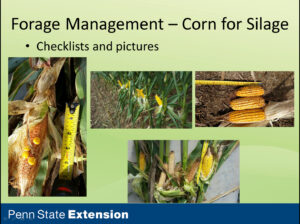
3. Example checklist filled out
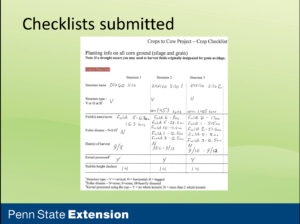
4. Results from the transition year. Corn silage NDF and Starch can vary substantially from fall and spring on some farms.
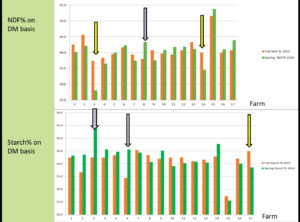
5. There are wide swings in fiber and starch digestibility. Our data shows that starch digestibility is not trending like refereed research shows. In fact, we are seeing the trend being the complete opposite, where starch digestibility is substantially lower in the spring vs. fall. Capturing cropping details on these 25 farms should help explain why this is occurring.
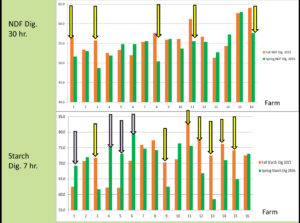
6. TMR intakes matching formulated rations and how they compare across farms with similar production. Some farms have very good agreement with the formulated diet, others are way off. In the official start of the project we will be comparing the nutrient specifications of the formulated diet and the actual analysis. We will also be comparing particle size of the TMR.
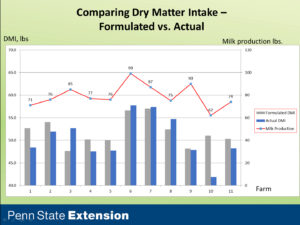
Collaborators:
Extension Specialist
324 Henning Building
University Park, PA 16802
Office Phone: 7172704391